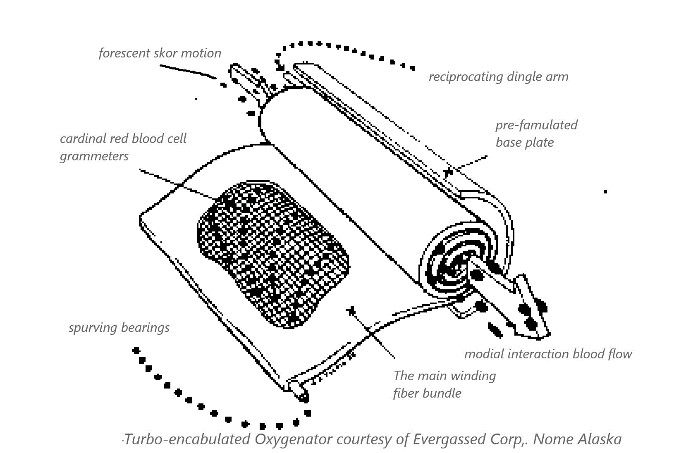The Turbo-encabulated Oxygenator by Gary Grist RN CCP Emeritus
Hey guys, I am excited about a new oxygenator from the Evergassed Corporation, Nome Alaska, a new manufacturer in the field. Below is a detailed description of the turbo-encabulated oxygenator.
Turbo-encabulated Oxygenator ( See Figure)

For a number of years now, work has been proceeding to bring perfection to the nebulously conceived idea of an oxygenator that would not only supply inverse reactive blood flow current for use in unilateral phase detractors and hemophiliacs but would also be capable of automatically synchronizing cardinal red blood cell grammeters. Such an instrument is the turbo-encabulated oxygenator.
Conductors, Fluxes and Roller Pumps
The only new principle involved is that instead of blood flow being generated by the relative motion of conductors, fluxes, and roller pumps, it is produced by the modial interaction of magneto-reluctance and capacitive diractance circumferentially.
Pre-famulated Amulite and Side Fumbling
This new oxygenator has a base plate of pre-famulated amulite surmounted by a malleable logarithmic casing in such a way that the two spurving bearings are in a direct line with the panametric fan. The latter consists simply of six hydrocoptic marzlevanes, so fitted to the ambifacient lunar waneshaft that side fumbling is effectively prevented; side fumbling being a major reason for oxygenator failure.
Stators And Girdle Spring
The main winding fiber bundle is of the normal lotus-o-delta type placed in panendermic semi-boloid slots of the stator, every seventh conductor being connected by a non-reversible tremie pipe to the differential girdle spring on the “up” end of the grammeters.
Repleneration
The turbo-encabulated oxygenator has now reached a high level of development, and it is being successfully used in operations on novertrunnions, cabbages, carrots and nasal septal reconstructions. Moreover, whenever a forescent skor motion is required, it may also be employed in conjunction with a drawn reciprocating dingle arm, to reduce sinusoidal repleneration.
To me, the most exciting aspect is this oxygenator’s ability to eliminate side fumbling which has been a problem for perfusionists since 1953.

I found myself in front of this article and, as if I were taking an advanced physics book, I didn’t understand anything. Could I have further clarifications on this? Thank you
Alessio
It is a joke:
“The turbo encabulator is a fictional electromechanical machine with a satirical technobabble description that became a famous in-joke among engineers after it was published by the British Institution of Electrical Engineers in their Students’ Quarterly Journal in 1944. Technical documentation has been written for the non-existent machine, and there are a number of parody marketing videos. Wikipedia”
Gary